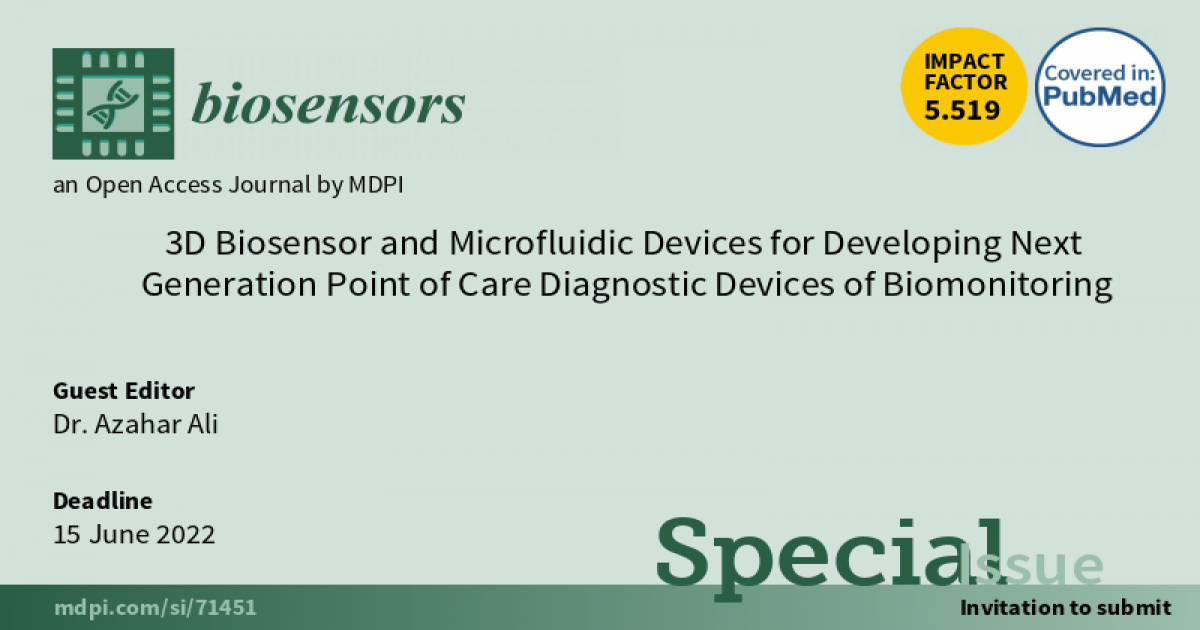3D Biosensor and Microfluidic Devices for Developing Next Generation Point of Care Diagnostic Devices of Biomonitoring
A special issue of Biosensors (ISSN 2079-6374). This special issue belongs to the section "Biosensor and Bioelectronic Devices".
Deadline for manuscript submissions: closed (15 June 2022) | Viewed by 11431

Special Issue Editor
Interests: microfluidic devices; advanced manufacturing; biosensors; nanomaterials; precision agriculture; livestock sensing
Special Issues, Collections and Topics in MDPI journals
Special Issue Information
Dear Colleagues,
The advent of additive manufacturing, i.e., 3D printing, has been a revolution for the manufacturing of next-generation point-of-care diagnostic devices, and has had an immense impact on industry and the economy. 3D printing is a layer-by-layer printing technique which evolves the printing of metals, ceramics, semiconductors, polymers, plastics, bioactive molecules and bioinks directly from a computer-aided design model in a controlled way. It is a rapidly advancing technique which accelerates the manufacturing of biosensing and microfluidic elements with complex geometries, and different materials structures and counterparts. Since the invention of stereolithography in 1980, there have many innovations in 3D printing techniques based on their applications for biomedical devices. This is because of their unique manufacturing advantages such as rapid prototyping, high uniformity of parts, reasonable resolution, customizability, minimizing material wastage, scalability, and their well-defined structure. Unlike traditional methods of manufacturing, including lithography, 3D printing does not require a lithographic mask, chemical wet/dry etching, or clean room facilities, thus reducing the manufacturing costs. Many methods of 3D printing based on extrusion, direct ink printing, selective laser sintering, aerosol jet, ink jet and two photon polymerization are being explored to manufacture numerous biomedical devices with high performances. The integration of 3D micro and nanostructures into microfluidic biosensors can provide new and multifunctional sensing modalities with unprecedented capabilities due to the larger surface of biomolecular interactions, such as high sensitivity, low limit-of-detection, and high reproducibility. 3D printing can also allow the printing of polymeric materials with different types of microfluidic devices with complex geometries and enables wearable technology with embedded electronics, leading to a new generation of point-of-care diagnostic devices for health monitoring. Thus, 3D biosensors with their high sensing capabilities can be promising tools for in vitro diagnostics of molecular biomarkers and implantable sensors to monitor electrophysiological parameters.
This Special Issue will cover the recent advancement of “3D biosensor and microfluidic devices for developing next-generation point-of-care diagnostic devices of biomonitoring”. It will be interesting to discuss the current challenges and future scope of 3D printing regarding point-of-care diagnostics devices.
Dr. Azahar Ali
Guest Editor
Manuscript Submission Information
Manuscripts should be submitted online at www.mdpi.com by registering and logging in to this website. Once you are registered, click here to go to the submission form. Manuscripts can be submitted until the deadline. All submissions that pass pre-check are peer-reviewed. Accepted papers will be published continuously in the journal (as soon as accepted) and will be listed together on the special issue website. Research articles, review articles as well as short communications are invited. For planned papers, a title and short abstract (about 100 words) can be sent to the Editorial Office for announcement on this website.
Submitted manuscripts should not have been published previously, nor be under consideration for publication elsewhere (except conference proceedings papers). All manuscripts are thoroughly refereed through a single-blind peer-review process. A guide for authors and other relevant information for submission of manuscripts is available on the Instructions for Authors page. Biosensors is an international peer-reviewed open access monthly journal published by MDPI.
Please visit the Instructions for Authors page before submitting a manuscript. The Article Processing Charge (APC) for publication in this open access journal is 2700 CHF (Swiss Francs). Submitted papers should be well formatted and use good English. Authors may use MDPI's English editing service prior to publication or during author revisions.
Keywords
- additive manufacturing
- 3D printing
- 3D biosensors
- point-of-care diagnostics devices
- microfluidic devices
- health care monitoring






